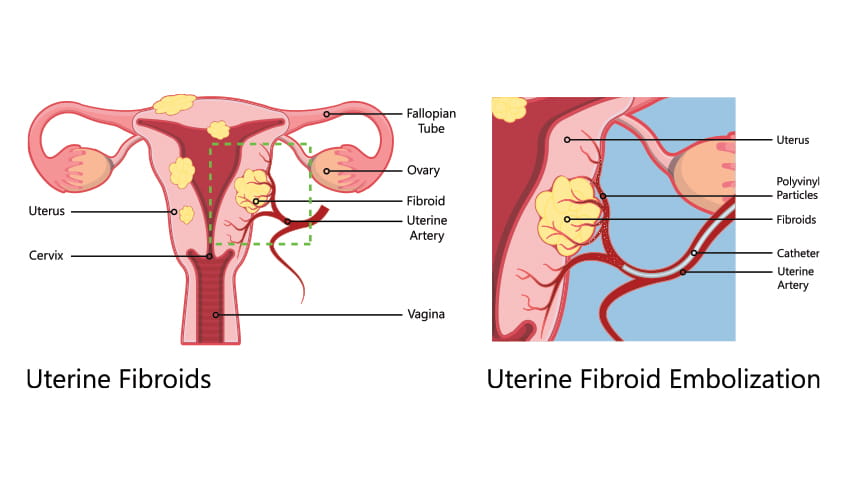Uterine Fibroid Embolization
For women seeking a minimally invasive solution for treating their uterine fibroids, uterine fibroid embolization (UFE) is becoming a popular choice. In most cases, the recovery process is faster than a myomectomy or hysterectomy due to the minimally invasive nature of this procedure.
Uterine fibroid embolization, also known as uterine artery embolization, is a minimally invasive procedure that is performed by an interventional radiologist (IR), a medical doctor with extensive experience in minimally invasive procedures. UFE can offer symptom relief from uterine fibroids.
What is uterine fibroid embolization?
When it comes to effectively treating uterine fibroids, there can be a lot of options to consider. In the past, a hysterectomy was the standard surgery used to treat fibroids, since removing the uterus entirely was the only way to guarantee relief from symptoms. Thankfully, recent advancements in medical technology have allowed for more minimally invasive methods to be made available, including uterine fibroid embolization. Uterine fibroid embolization may also be referred to as uterine artery embolization (UAE).
Uterine fibroid embolization is a less invasive procedure for uterine fibroid treatment. UFE typically takes less than an hour to perform and requires only a small incision. The procedure is designed to block the blood supply to the uterine fibroids, which causes them to shrink. As one of the alternatives to hysterectomy procedures, UFE is clinically proven to reduce the major symptoms of uterine fibroids.
We offer a variety of appointment types. Learn more or call 913-588-1227 to schedule now.
Who can have uterine fibroid embolization?
The best candidates for uterine fibroid embolization are:
- Women who are experiencing the symptoms of uterine fibroids
- Women who are not pregnant
- Women who do not want surgery
- Women who may be poor surgical candidates
- Women who want to retain their uterus and are looking for alternatives to hysterectomy
How does uterine fibroid embolization work?
At The University of Kansas Health System, our interventional radiologists are highly skilled in performing intravenous procedures such as UFE. Rather than make a surgical incision to the uterus, or even anywhere in the pelvis, our specialists are able to treat fibroid(s) by threading a thin tube through a small cut in the groin or wrist. The tube, also called a catheter, is carefully maneuvered through the arteries until it reaches the target area.
Once in place, an embolic fluid is injected through the catheter and into the targeted arteries. This fluid then works to block blood flow within the artery, which effectively cuts off the blood supply to the uterine fibroid being treated. This may be applied to as many fibroids as needed, and the blood then recirculates through other arteries in the pelvis.
Uterine fibroid embolization is typically performed on an outpatient basis, meaning that you may return home following your procedure. Over the next several weeks, fibroids should gradually reduce in size as they continue to not receive the blood necessary for further development and growth.

Benefits and risks of uterine fibroid embolization
Compared to more traditional approaches to treating fibroids, UFE is much less invasive. Because UFE does not require a large incision or general anesthesia, there is a lower risk of potential complications and your recovery time is shortened. A majority of women who receive uterine fibroid treatment using UFE are able to return to regular daily activities in 1-2 days.
However, while uterine artery embolization is an effective treatment for uterine fibroids, there is no conclusive data or scientific results that establish the impact of uterine fibroid embolization on fertility and pregnancy. Therefore, before choosing this fibroid treatment, it is very important that you understand the potential inability to conceive in the future.
What happens during uterine fibroid embolization?
The entire fibroid treatment typically lasts less than 1 hour and is performed as an outpatient therapy. Prior to the procedure, some tests may have to be done. Your doctor will let you know of any preparation needed before your procedure.
Uterine fibroid embolization begins with a tiny incision in the femoral artery. Using specialized X-ray equipment, the interventional radiologist passes a catheter (small tube) into the femoral artery, to the uterine artery, and guides it near the location of the fibroid tumor.
When the catheter has reached the location of the fibroids, embolic material (small spheres) is injected through the catheter into the blood flow leading to the uterine fibroid tumors. The embolic material is designed to block the vessels around the fibroid, depriving it of the blood and oxygen it needs to grow. The blood and oxygen deprivation results in fibroids shrinking. The embolic material remains permanently in the blood vessels at the fibroid site.
Once embolization of the uterine artery has been completed on both sides, the catheter is gently removed and the incision is closed using a vascular closure device.
After the procedure, you may experience some discomfort such as abdominal cramping or pain. This may last a few days after your procedure. You and your doctor will determine what medications may be needed to keep you comfortable. You may remain in observation up to 23 hours, depending upon the decision of your physician.
Some people may experience “postembolization syndrome” following uterine fibroid treatment, which is described as having flu-like symptoms such as a low-grade fever, malaise (a vague feeling of discomfort) and mild nausea. Postembolization syndrome can occur within a few hours or up to a few days after uterine fibroid embolization.
Your discharge instructions will include information on post uterine fibroid treatment care. Most women are able to return to light activity within a few days and are back to work and normal activity within 11 days, on average.
Your doctor will schedule your postprocedure appointments to check your recovery. These appointments are usually 1 week postprocedure, and 3 months postprocedure.







